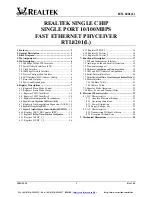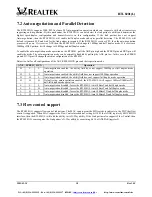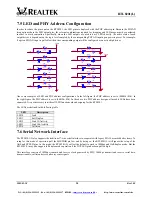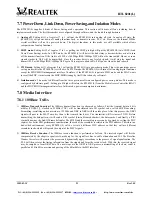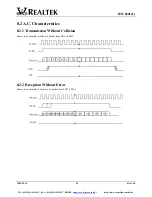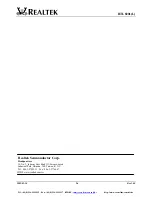
RTL8201(L)
2002-01-18
Rev.1.04
12
4:<6> 10FD
10Base-T-FD:
This bit advertises the ability to the Link Partner that the
RTL8201L can operate in 10Base-T full duplex mode. Writing a ‘0’ to
this bit will suppress the transmission of this ability to the Link Partner.
Resetting the chip will restore the default value. The default value is ‘1’
and writing a ‘1’ will set this bit to ‘1’. Reading this bit will return the
last written value or the default value if no write has been completed
since the last reset.
1: 10Base-T full duplex supported by local node
0: 10Base-T full duplex not supported by local node
1, RW
4:<5> 10
10Base-T:
This bit advertises the ability to the Link Partner that the
RTL8201L can operate in 10Base-T half duplex mode. Writing a ‘0’ to
this bit will suppress the transmission of this ability to the Link Partner.
Resetting the chip will restore the default value. The default value is ‘1’
and writing a ‘1’ will set this bit to ‘1’. Reading this bit will return the
last written value or the default value if no write has been completed
since the last reset.
1: 10Base-T is supported by local node
0: 10Base-T not supported by local node
1, RW
4:<4:0> Selector
Selector Field:
This field reflects the binary encoded selector supported
by this node. Bits 4:0 contain a fixed value of <00001>, representing
CSMA/CD, is specified. This indicates that the chip belongs to the
802.3 class of PHY transceivers. No other protocols are supported.
<00001>, RW
6.6 Register 5 Auto-Negotiation Link Partner Ability
(ANLPAR)
This register contains the advertised abilities of the Link Partner as received during Auto-negotiation. The content changes
after the successful Auto-negotiation if Next-pages are supported.
Address
Name
Description/Usage
Default/Attribute
5:<15> NP
Next Page:
Bit 15 returns a value of ‘1’ when the Link Partner
implements the Next Page function and has Next Page information that
it wants to transmit. However, since the RTL8201L does not implement
the Next Page function, it ignores the Next Page bit, except to copy it to
this register.
0: Transmitting the primary capability data page
1: Transmitting the protocol specific data page
0, RO
5:<14> ACK
Acknowledge:
Bit 14 is used by Auto-negotiation to indicate that a
device has successfully received its Link Partner’s Link Code Word.
1: Link partner acknowledges reception of local node’s capability data word
0: No acknowledgement
0, RO
5:<13> RF
Remote Fault:
Bit 13 returns a value of ‘1’ when the Link Partner
signals that it has detected a remote fault. The RTL8201L advertises this
information, but does not act upon it.
1: Link partner is indicating a remote fault
0: Link partner does not indicate a remote fault
0, RO
5:<12:11> Reserved
Reserved:
Ignore the output of the RTL8201L when these bits are
read.
5:<10> Pause
Pause:
Indicates that the Link Partner pause bit is set.
1: Flow control is supported by Link partner
0: Flow control is NOT supported by Link partner
0, RO
5:<9> T4
100Base-T4:
This bit indicates that the Link Partner can support
100Base-T4 mode. This bit is cleared any time Auto-negotiation is
restarted or the RTL8201L is reset.
1: 100Base-T4 is supported by link partner
0: 100Base-T4 not supported by link partner
0, RO
Tel: +49(0)234-9351135 · Fax: +49(0)234-9351137
E-MAIL:
http://www.
cornelius-consult.de

